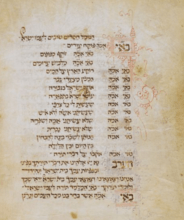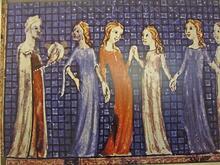Ginevra Blanis
Ginevra Blanis was a late sixteenth-century silk manufacturer of the Florentine ghetto and Siena. The granddaughter and daughter of distinguished physicians, she drafted a will (1574) that included specific bequests, including charity for the Jewish poor, education for boys, and dowries for poor Jewish girls in the newly established ghetto. Blanis made her mark as a patron of the arts with her commission of a silver lamp and a woven curtain for the synagogue’s ark. Despite her elevated status and financial independence, Ginevra, as a woman, was never elected to the ghetto’s governing board. Instead, the businesswoman left her mark as a founder of the young community with her philanthropy, albeit on a modest scale, and in the public communication of what she considered Jewish values in the provisions of her will.
Ginevra Blanis was a sixteenth-century Italian Jewish woman of the merchant-professional elite. The Italian archives have not yet revealed details of her birthplace or childhood, but her family most probably had Catalan origins and roots in Rome, Umbria, and Tuscany. Born c.1551, Blanis moved to the newly created ghetto of Florence in the early 1570s and matriculated into the linen guild and quickly thereafter into the more prestigious silk guild, which controlled one of the most important industries in the state. Blanis is significant not only because of her unusual status as a member of two Florentine guilds; nor because she retained her family surname after her marriage (unusual for Italian-born Jewish women); but because she left a 1574 will that defines her as founding member, shaper, and donor to the early modern Jewish community of the ghetto of Florence.
Family
Ginevra (also spelled Genebra and Genevera) Blanis came from a wealthy family of doctors and bankers, although a class below Jewish aristocrats Graçia Nasi and Benvenida Abravanel. Her paternal grandparents were Stella and the distinguished physician Maestro Laudadio de’ Blanis, who lent money to artisan and noble families in Perugia, invested in local mercantile and industrial enterprises, and had an interest in The esoteric and mystical teachings of JudaismKabbalah. Ginevra’s parents were Agnolo (physician and author of a well-known elegy for the Jewish martyrs of Ancona in 1554) and Belloccia, or Belottia, a daughter of Manuele da Montolmo, a banker. She was born c. 1551 and already married by 1567 to Agnolo, son of Moise of Perugia, with whom she appears in a document of that year as an agent for the Jewish bankers Moise and Simone da Rieti of Siena. Ginevra’s early marriage (she was no older than sixteen and may have been fourteen or fifteen) was on the young side of typical for Jewish girls from wealthy families in the Italian states at this time.
In 1570 Ginevra’s grandparents were living in Florence with a large household of nine, while other close relatives lived in nearby Monte San Savino. The young woman moved to Florence either before or just after the Medici grand-ducal edict of ghettoization in 1570, when the 712 Jews of Tuscany were expelled from more than twenty cities and villages. Some Jews chose to convert in order to stay in place, while the super-elite moved to other states rather than to the Florentine ghetto that was constructed in 1571. Most of the extended de Blanis family settled in the ghetto. Ginevra’s husband did not play a noticeable role in the ghetto, appearing infrequently in the archival record. It is likely he was working or studying out of the city. Possibly in apprehension of childbirth, Ginevra wrote a will in 1574 that included specific bequests to her community and to a nephew and made her husband her universal heir. She probably had no surviving children at the time. A census of April 1612 has Ginevra in Siena, living at age 61 with another woman close to her in age.
Status and Economic Activity
Scholars have often pointed to marriage strategies to explain how elites maintained class status, but Ginevra’s life shows that women also strategized in business and patronage to protect themselves and their families. In 1574, between 400 and 500 Jews lived in the ghetto of Florence: local Jews, immigrants from the papal territories, a few Jewish merchants with connections to the Ottoman empire, and refugees from other parts of Tuscany expelled by order of the grand duke, Cosimo I de’ Medici. Blanis successfully negotiated the crisis of ghettoization by entering into the Florentine economy as an independent businesswoman.
In August 1573, Ginevra first entered the linen guild, which controlled the Florentine market in used clothing and related needle-trades. She was probably sponsored by her brother Laudadio d’Agnolo, who had been admitted the previous year. In September she was admitted to the more exclusive silk guild (the Arte della Seta), which her grandfather Laudadio de’ Blanis had joined in 1572 in his old age. It seems very likely that he did so in order that his grandchildren could matriculate under rules that admitted only citizens and immediate relatives. Successfully using her own status to her family’s advantage in a guild governed and populated almost exclusively by men (only one other Jewish woman is listed among the guild books between 1571 and 1600), Ginevra then sponsored her husband for membership in the linen guild in 1575.
The sponsorship of a man by a woman was very unusual. It is not clear that Agnolo was ever active in the business, and it is possible she sponsored him in order to protect her own place, given the risk at the time to women’s membership status. Whether her independent wealth came only from gifts or bequests made to her by relatives, or from profit from her own business, Ginevra controlled an estate. Like many other women, she side-stepped Jewish law, according to which all of a married woman’s possessions were inherited by her husband, by dictating a detailed will before a notary in 1574 (see below).
Ginevra likely received a good education in Italian language and literature and some in Hebrew studies. Some women of the banking and rabbinic elites in the late fifteenth to early seventeenth century commissioned scribes to copy Hebrew manuscripts for their own use, owned prayerbooks, and corresponded in Hebrew. However, there is no evidence that Ginevra participated in this erudite world of learned women; her sphere seems to have been the world of business.
Ginevra’s Will
It is Ginevra’s last will and testament that makes her particularly interesting. The most noteworthy provisions in the will are those that anticipated or perhaps established the individuated communal funds and charitable societies in the ghetto. Historians generally assume that Jewish communal needs were met by key Jewish institutions, but it rare to catch the moment in any one place when these institutions were first organized and funded, let alone envisioned. Blanis focused on the needs of both girls and boys in the community, strengthening traditionally gendered norms. Each bequest expressed a vision of the social, religious, and educational structure necessary to help the resettled Jews become a stable Jewish community. Her will is distinguished in this way from many others at this time, which might include a contribution to a charitable society but focused on the payment and forgiveness of debts, promises of dowries, and the terms and distribution of personal legacies (including, especially for elite men, their books).
Registered on August 4, 1574, with a Christian notary, Ginevra Blanis’s will included instructions for the “care of her soul,” including her burial; specific detailed communal and charitable bequests; bequests related to her artistic patronage; and the designation of her heirs. Although by default Jewish law makes a husband the universal heir, Ginevra noted this explicitly and chose as his successor her nephew Laudadio, namesake of her grandfather, should Agnolo predecease her childless. Other women in her family were promised dowries of 300-600 scudi, and Ginevra probably expected to have that much and more to dispose of. She designated 140 scudi to pious bequests, including ten scudi for candles or oil for the synagogue and ten to the Society of the Misericordia of the Jews of Florence, a burial and charitable society (“Gemilut Hasadim”) that may have predated the ghetto. (This society was referred to in the Latin will with the same name as the famous Christian charitable aid confraternity active in Florence since the fourteenth century.)
Jewish Values, Gender, and the Arts in Ginevra’s Will
Moving beyond her bequest to the small charitable society, Ginevra endowed funds that had not yet been established, and these she instructed her heirs to distribute over a period of time. First, she left ten scudi “for the instruction of poor Jewish boys”. She also set aside 30 scudi for Jewish paupers. In a strikingly detailed bequest, Ginevra instructed her executor to dispense 80 scudi to finance the marriages of eight poor girls, two each year. Charitable dowry societies became a common institution in most larger Jewish communities in Italy, but only in the early seventeenth century. The dowries Ginevra endowed compared favorably to those given in charity to girls nominated by members of her Florentine linen guild, which distributed funds left to it by two pious benefactors. Finally, Ginevra left 20 scudi for the commission of a silver chandelier and a curtain for the ark, about which she specified that “the Jews shall promise that they shall call [them] mine.” This donation of lamp and synagogue textile marked Ginevra’s piety, quest for immortality, and material and visual assertation of her status as a patron of the community. Ginevra’s wishes may reflect the custom of early modern Jewish women of embroidering their names or those they wished to honor on religious textiles, including curtains for the ark, or Aron ha-Kodesh, in the synagogues. We may speculate that weavers of her own silk firm (which could have employed the poor men and women she intended to support with her donations) were the ones who would weave and embroider it.
Blanis’s will offers an unusually clear expression of the needs and commitments of a Jewish woman of the urban merchant-professional class in the late sixteenth century. She took care to assure the future of her soul with instructions for her proper burial and gifts. She also intended to memorialize and perpetuate her own name, which may have been particularly important to her as a woman with no children. But it was to the new Florentine ghetto community’s future that she unequivocally committed herself and in which she invested when she dictated her testament. Her will can therefore also be called a kind of “ethical will” and an “ego-document”—terms that have not been applied to Jewish women’s writing before the seventeenth century. At the same time that she dictated the record of her own foresightedness, Blanis reinforced the Jewish gender roles that made an education the most critical asset necessary for the survival of a young man and a dowry the most critical asset for the survival of a young woman.
Family History
The 1574 testament of Ginevra Blanis is found in the Archivio di Stato di Firenze, Notarile Moderno, Testamenti 767, 167r–v. The document is reproduced by permission of the Ministero per i Beni e le Attività Culturali in Stefanie Siegmund, The Medici State and the Ghetto of Florence: The Early Modern Construction of a Jewish Community (Stanford University Press, 2006), fig. 9, pp. 390-91. My full translation from the Latin with notes is available at the website of the Early Modern Workshop: Resources in Jewish History (https://research.library.fordham.edu/emw/)
Braverman, Nardo Bonomi “Un censimento degli ebrei di Siena.” Materia Giudaica XIV/1-2 (2009): 485-92.
Siegmund, Stefanie Beth. The Medici State and the Ghetto of Florence: the Construction of an Early Modern Jewish Community. Stanford: Stanford University Press, 2006. Note: This article corrects a typo (p. 555, n. 227): Ginevra’s parents’ marriage was in 1558, not 1548.
Toaff, Ariel. “Maestro Laudadio de Blanis e la banca ebraica in Umbria e nel Patrimonio di S. Pietro nella prima metà del Cinquecento.” Zakhor I (1997): 95-116; however, Toaff is incorrect that Ginevra’s grandfather died in 1565.
Related Works on Italian and Sephardic Jewish women
Adelman, Howard Tzvi. “Italian Jewish women at prayer.” In Judaism in Practice from the Middle Ages through the Early Modern Period, edited by Lawrence Fine, 52-60. Princeton: Princeton University Press, 2002.
Adelman, Howard Tzvi, “Religious practice among Italian Jewish women.” In Judaism in Practice from the Middle Ages through the Early Modern Period, edited by Lawrence Fine, 203-09. Princeton: Princeton University Press, 2002.
Blasco Orellana, Meritxell J. Ramón Magdalena Nom de Déu, and Miguel Ángel Motis Dolader, “Últimas voluntades de los judíos en Aragón: El testamento de Doña Oro, esposa de Samuel Rimok, judía de Monzón (1463).” Materia Giudaica XIV/1-2 (2009): 431-57.
Boccato, Carla. "Aspetti della condizione femminile nel ghetto di Venezia (secolo XVII): I testamenti." Italia: Studi e ricerche sulla storia: La cultura e la letteratura degli Ebrei d'Italia. 10 (1993): 105-35.
Boccato, Carla, “Ebree nella vita privata a Venezia nel Seicento attraverso i testamenti.” Associazione italiana per lo studio del Giudaismo: Atti del Convegno IX (2007): 263-77.
Contessa, Adreina. "The Mantua Torah ark and Lady Consilia Norsa." Ars Judaica; the Bar-Ilan Journal of Jewish Art (2016): 53-70.
Frank, Karen. “Jewish women and property law in medieval Umbria.” In Across the Religious Divide: Women, Property, and Law in the Wider Mediterranean (ca. 1300-1800), edited by Jutta Sperling and Shona Kelly Wray, 95-108. London: Taylor & Francis Group, 2009.
Greenblatt, Rachel L. To Tell Their Children: Jewish Communal Memory in Early Modern Prague. Stanford: Stanford University Press, 2014, 63-66.
Orfali, Moises. “The Portuguese Dowry Society in Livorno and the Marrano diaspora.” Studia Rosenthaliana, vol. 35, no. 2 (2001): 143–156.





